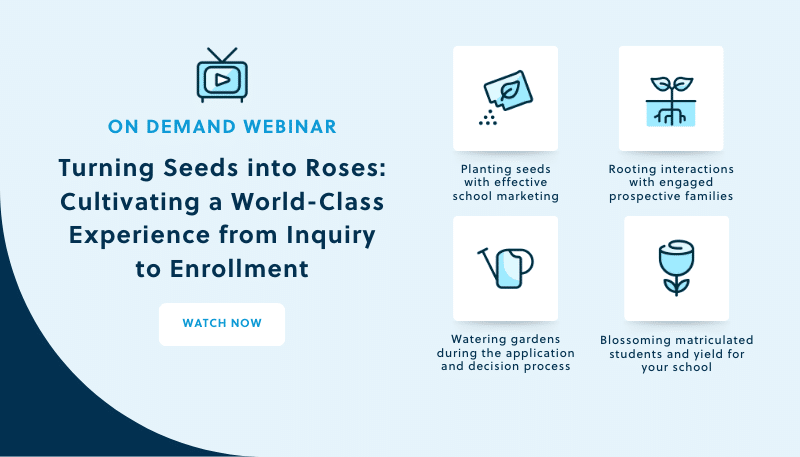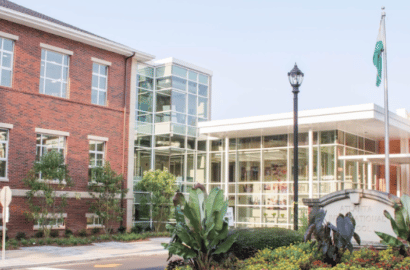
Admission offices are a well-oiled machine. Applications are due around the same time each year, decisions are announced like clockwork, and families are welcomed with similar tactics across the board. But sometimes change is necessary — especially to keep up with evolving admission trends.
For example, many schools pivoted to meet their community’s needs during the pandemic. Not all changes were laid to rest after returning to campus. We spoke with two admission professionals about how their schools have both adapted and embraced changes from the pandemic era to increase applications, yield, and relationships. Keep reading for five major takeaways and ideas to try at your own school.
Prioritizing Personalization
Schools were talking about the evolution of the admission funnel long before the pandemic. Nija Meyer, VP for Enrollment Management at Woodward Academy, believes that COVID-19 only accelerated its disruption.
“I think during the pandemic, the funnel almost eroded. After the pandemic, people jumped straight to the application process,” she says. “We may receive an application from someone who hasn’t even toured campus yet or who hasn’t learned basic things about the academy yet.”
As a result, Woodward Academy restructured their marketing and admission process. Their goal? To meet families where they’re at, in whatever enrollment stage that may be. Using HubSpot as their customer relationship management software, Woodward Academy created automatic workflows that send relevant content based on a students’ stage in the funnel or unique area of interest.
“It’s really important to us to make a big school feel small, and the best way to do that is through individualized experiences,” says Meyer. “Plus, it ties in with what today’s families want: knowing that we’re taking the time to know their child as a unique person with unique strengths.”
Taft School in Watertown, CT is also serious about personalization. With Veracross as their central database, the admission team can easily segment student data based on location, grade, or resident status. They can then use these segments to send relevant marketing content to each audience.
“There’s so many different ways that we can break [data] apart… I love the ability to easily gather groups and send them targeted messages,” says Kelly Gereski, Database Administrator at The Taft School.
Putting Information on Autopilot
Another byproduct of the shifting enrollment funnel is information: families want it now. Both Woodward Academy and The Taft School use a Veracross admissions portal to share information quickly and efficiently with prospective families. This portal acts as a one-stop shop for everything from applications to admission checklists, virtual tours, frequently asked questions, and more.
“My goal is to continue using the admissions portal as much as possible,” says Gereski. “People are becoming more and more tech savvy and we need to get information at their fingertips in a way that’s easy for them… They want to be able to find it on their own.”
Embracing Virtual Options
As we all know, COVID-19 paved the way for remote connections at school, at work, and even at the gym. Many schools have realized the impact of tools like Zoom to not only offer remote learning but to enhance the applicant experience even to this day.
Taft School, for example, attracts prospective families from all over the world. Before the pandemic, they rarely conducted virtual interviews, requiring families to travel lengthy distances to visit campus. They’ve since realized the value of remote interviews as a way to reach more applicants near and far.
Similarly, Woodward Academy has continued to offer virtual tours and interviews post-pandemic. These options provide flexibility for families and make it easier to explore the school from afar. If a family signs up for a virtual tour, they are also paired with an admission officer for an interview during the tour. “We wanted to maintain that personal feel that we had during the pandemic,” says Meyer.
Experimenting with Marketing
We can’t talk about admission trends without discussing the shift from public to private education. Many public school families transferred to private schools during or after the pandemic. This was largely due to the enhanced remote learning offerings at private K-12 schools. As a result, private school marketing teams leaned into the opportunity to educate families about private versus public education.
Woodward Academy created gated content that highlighted the benefits of a private school education. They also optimized their website for SEO keywords relating to private versus public schools and ran paid search campaigns in support of these efforts.
Before the pandemic, just 25% of Woodward Academy’s applications came from public school families. In 2020, nearly 40% of applicants came from nearby public schools, a trend that continued in 2023 with one-third of applicants hailing from public education. While schools are unsure if this will continue, there is still ample room to learn from this trend and capitalize on it.
Redirecting When Necessary
The pandemic also encouraged schools to analyze their current admission processes and identify what was actually generating yield.
For example, open houses are considered a staple for K-12 admission teams. But when Meyer dug into the data at Woodward Academy, she was surprised by her findings. Only 25% of students who attended campus open houses ended up applying to the school. This observation created an opportunity to reimagine open houses and make them more valuable for both families and the school.
Instead of open houses for all prospective families, Woodward Academy now hosts revisit days for accepted families. Revisit days are an opportunity for students to spend time on campus right before they make their enrollment decision — instead of visiting campus in the fall and waiting several months to hear back from the school. “We use our revisit days to bring Woodward Academy back to top of mind,” says Meyer.
The Taft School also pivoted. For many years, they offered the Standard Application Online (SAO). In 2023, they introduced the Gateway Application in addition to SAO. They were surprised to see that applicants were split fifty-fifty in their application of choice — in a record-breaking application year, no less! These numbers encouraged the school to continue offering both applications to enhance the experience for families.
Changing Admission Trends
These are just a few examples of how K-12 admission offices have pivoted to keep up with changing admission trends. Schools will undoubtedly continue to evolve and shift their admission approach in years to come.
For more information on meeting your families’ needs during the admission process, catch up with our on-demand webinar featuring Kelly Gereski.




